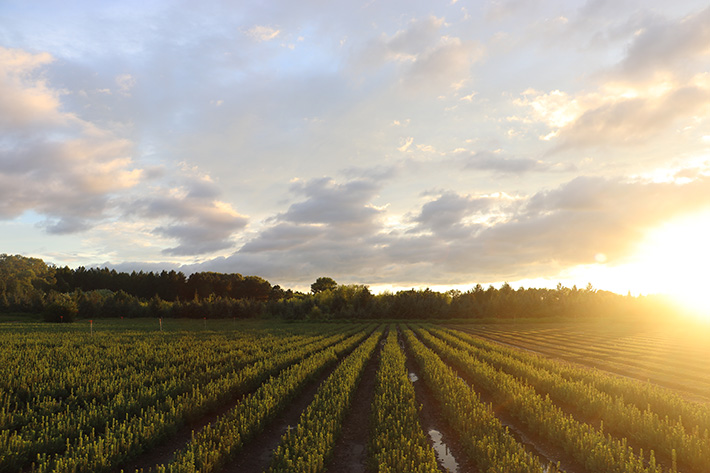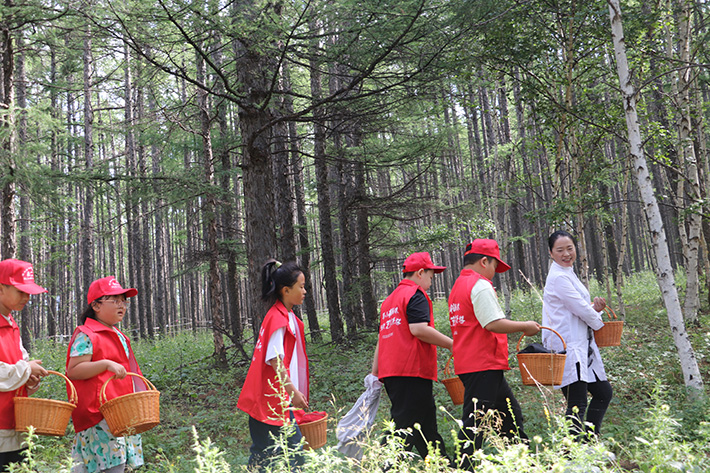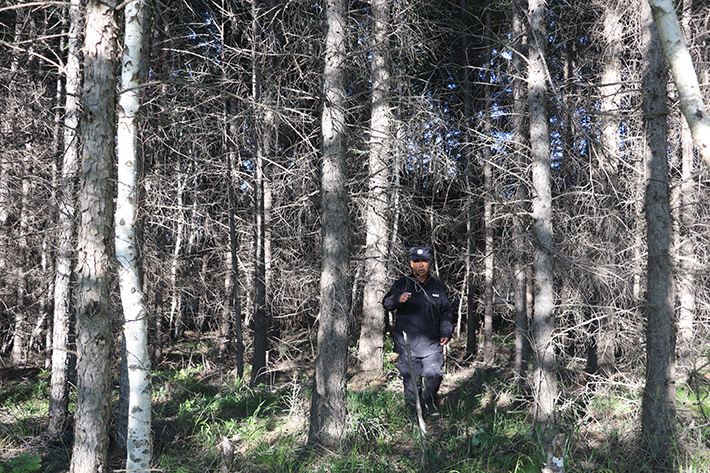|
||||||||||
| Home Top News Economy/Tech Culture/Sports China in Foreign Eyes Green Development Videos Intangible Cultural Heritages |
|
||||||||||
| Home Top News Economy/Tech Culture/Sports China in Foreign Eyes Green Development Videos Intangible Cultural Heritages |
| ChinAfrica |
| Custodians of Nature |
| Inner Mongolia’s forest protection paves the way for sustainable development |
| By Ge Lijun | VOL. 17 October 2025 ·2025-10-10 |

A nursery for the Three-North Windshield Forest Programme at the Yakeshi Forest Farm, Hulun Buir, Inner Mongolia Autonomous Region, on 2 August (HU FAN)
Tucked away in the northeastern corner of China’s Inner Mongolia Autonomous Region, the vast forests of the Greater Hinggan Mountains have undergone a remarkable transformation. Once heavily threatened by commercial logging, this region now exemplifies the transition to ecological preservation, with local communities incorporating conservation into their daily lives and future plans.
Caring for the land is part of the family tradition, and people have found new ways to sustain their livelihoods while keeping nature at the heart of what they do. The Greater Hinggan Mountains stand as living proof that conservation fosters not only greener landscapes, but also hope, growth, and new opportunities for all who call it home.
Generations of guardians
At the heart of this green transformation lies the Baogeda Mountain Forest Farm, situated on the western slopes of the Greater Hinggan Mountains in the East Ujimqin Banner. As one of the largest forest farms in Xilin Gol League, Baogeda holds the region’s richest forestry resources and serves as the source of the Ulagai River, the largest inland river in Inner Mongolia.
In 2011, a sweeping reforestation initiative was launched to strengthen the region’s ecological functions, with a particular focus on water source conservation. More than 340,000 mu (22,666 hectares) of new forests have been planted, extending forest coverage beyond the area’s original natural forests. In effect, Baogeda has witnessed the emergence of a new forest alongside the old.
As the ecosystem improved, wildlife began to reclaim its habitat. For Bao Yongli, a veteran forest ranger with nearly four decades of service, this renewal presents new challenges: “Deer nibble at the young shoots, and we are seeing more rabbits, wild boars, and even wolves,” he noted.
Known as the “elder” of the forest farm, Bao, now 57, has dedicated his career to the woods, beginning as a lumberjack, then working as a forester, before being retrained as a ranger in 2006. His daily duties include monitoring fire risks, detecting disease outbreaks, preventing illegal logging, and promoting public awareness.
Beneath the calm of his daily routine, real dangers are never far away. Bao has participated in around 10 fierce firefighting operations and still bears the scars of a serious injury from a forest fire in 1987, enduring proof of his steadfast dedication and courage.
Bao’s watch post occupies a remote frontier, where forest transitions into the steppe near the China-Mongolia border. As a lone sentinel against fires that could sweep in from the grasslands, he undertakes long patrols of over 10 km a day across rugged, unforgiving terrain, even with the help of motorcycles. “I felt lonely at first,” Bao admitted. “But now I’ve grown used to it. When I’m tired, I lie down on a slope or lean against a tree and drink from a mountain spring. It’s a simple joy.”
His greatest pride comes from witnessing the forest’s revival and the return of biodiversity. Like his father, who arrived in 1957 to help to establish the forest farm, Bao has devoted his life to this land. His commitment continues through both of his sons, who, after graduating from university, joined the wildfire response team. This generational legacy has helped to secure the preservation of this natural heritage.
Today, economic opportunities are emerging. With the launch of China’s national carbon market, East Ujimqin Banner signed agreements in 2022 to develop forest carbon sink projects. Early estimates suggest these newly planted forests could reduce greenhouse gas emissions by over 60,000 tonnes a year, providing a novel way to realise the value of these vital ecosystems.

Fu Lihong (right) and her students at an educational workshop in the forest in Arxan, Hinggan League, on 31 July (HU FAN)
Sustaining a legacy
In Arxan at the heart of Hinggan League, a monument stands as a symbol of the city’s spirit: “Develop and replant for green mountains to leave 1 million mu of forest for future generations.”
For decades, this multi-ethnic town of 68,000 people, nestled in the southwestern foothills of the Greater Hinggan Mountains, bore the consequences of reckless logging. Starting in 1954, local residents carried out continuous reforestation programmes, and by 1992, artificial forests spanned 1 million mu (66,667 hectares). Two decades later, Arxan emerged as a pioneer, halting all commercial logging in its natural forest.
Today, a new generation is taking the lead. At just 26, An Zhengxin has chosen to become a forest surveyor, following in the footsteps of his father and great-grandfather. “Forest surveys are the foundation of forestry,” An said. “I want to carry the torch and pass it on to the next generation.”
Arxan now boasts a forest coverage rate of 81.2 percent. Its restored environment not only sustains local life, but also draws tourists. Fu Lihong, 49, has built her career on this ecological wealth. The daughter of a forest surveyor, she first established a travel agency and more recently opened a “forest art” workshop. She collects pinecones and leaves touched or moved by squirrels and woodpeckers, and transform them into nature-inspired artworks.
In 2023, her works were exhibited in Beijing at the award ceremony of the China-Africa Children’s International Cartoon Competition, earning admiration from distinguished visitors from Kenya and Morocco.
Fu also organises hands-on workshops that combine ecological education and artistic practice. “I want to blend culture and tourism so more people can discover our natural resources and unique identity,” she explained.

Bao Yongli, forest ranger, patrolling among the trees in Baogeda Mountain Forest Farm, Xilin Gol League, Inner Mongolia Autonomous Region, on 30 July (HU FAN)
Towards a sustainable future
In Yakeshi, located within Hulun Buir City, forest management has grown far beyond protection. Today, the local forest farm operates as a diversified enterprise - producing saplings, cultivating fruit and mushrooms, and promoting eco-tourism and recreational activities.
Since 2000, its nurseries have supplied young trees for China’s Three-North Shelterbelt Forest Programme, which aims to establish vast windbreaks across north China. The nurseries have created over 20 stable jobs, with monthly salaries averaging around 3,000 yuan ($422). Plans are underway to expand the nurseries to 2,000 mu (133 hectares) by 2033.
Innovation is evident inside the greenhouses, where technicians develop unique products such as yellow-rind watermelons, golden fungus, and a locally branded variety of black fungus. The floriculture areas cultivate over 30 species of ornamental plants, including lilies, gladioli, and dahlias.
A new leisure centre now welcomes visitors for eco-tourism experiences, water sports, fruit picking, and local cuisine. Each year, more than 10,000 tourists visit. Tourism has grown rapidly - in 2024, Yakeshi received 2.86 million visitors, generating over 3.5 billion yuan ($492 million) in revenue, a year-on-year increase of 22.66 percent.
Behind this vitality stands a clear vision: to turn the forest into a lasting engine of economic strength. With roughly 80 percent forest coverage, Yakeshi stands as proof that nature is worth its weight in gold. By linking forestry with tourism, Yakeshi is creating a model where ecological protection, economic opportunity, and community development move forward together.
|
||||||||||||
| About Us | Contact Us | Advertise with Us | Subscribe |
| Copyright Beijing Review All rights reserved 京ICP备08005356号-5 京公网安备110102005860号 |